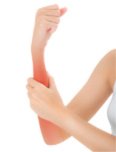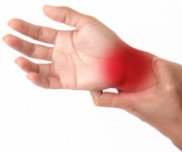The Reverse Stretch
Recovering from a repetitive strain injury requires vigilance. When symptoms are at their worst, or you are just beginning your path toward recovery, the more you stretch gently and consciously, the better.
Restoring your body to a more normal state appears to be a very front-end loaded process. By that I mean that you have to spend more time in the earlier stages of recovery doing things that enhance the restoration and healing of your injured arms, hands, neck and shoulders. This requirement will shift as more and more tissue returns to its normal state. You’ll eventually need to spend only a few minutes a day maintaining the balance you’ve achieved. But first, there’s a lot of work to do.
Here’s a good stretch to practice periodically throughout your workday. This exercise helps eliminate the stresses that build as a result of how you use your body in your job. Fortunately, it can be customized to help you whether your job is in front of a computer, on an assembly line, or you spend much of your day carrying a baby.
This is an exercise of reversals. Reversing your common body positions helps undo the physical stresses that build as a result of the constant postures and positions required by your job or your waking hours activities. Here’s how to do it:
First, choose a posture to reverse-stretch. A good starting point is to choose a position you find yourself in frequently during your day.
Follow these steps:
• If your fingers are curled and close together, straighten them and spread them apart.
• If your wrist is bent, bend it in the opposite direction.
• If your elbow is bent, straighten it.
• If your arm is forward of your body, extend it behind your body.
• If your arm is down below shoulder level, raise your arm above your shoulders.
Putting all these position changes together, hold the reverse-stretch for ten seconds, then put your hand in your lap and rest there until all stretch sensations fade completely. If possible, repeat the same reverse-stretch at least one more time.
Customize the reverse-stretch for your own personal situation. Make as many position reversals as you can without causing pain. Moderate your position so that you never experience pain with this stretch. Resting your hand in your lap at the end of each repetition helps prevent delayed discomfort from the stretch, while at the same time allowing the body time to register the changes that have been asked of it and enough time to actually accomplish those changes.
Click the block below that most closely matches your injury for more information and to find the Toolkit we offer to help you in your recovery.







